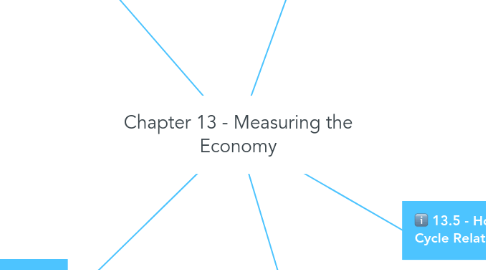Chapter 13 - Measuring the Economy
by Cassidy Hamre


1. 13.2 - How Do Economists Measure the Size of an Economy?
1.1. The main measure of the size of a nation’s economy is its gross domestic product. A growing GDP is generally considered a sign of economic health.
1.2. Economists use GDP figures to determine not only how big an economy is, but whether it is growing or shrinking.
1.3. To compensate for the effects of inflation, the Commerce Department calculates what is called real GDP, which measures the output of an economy not in current dollars.
1.4. Per capita GDP is an accepted measure of a society’s standard of living. As a country’s per capita GDP increases, so too do other indicators of well-being, such as literacy and education, health and life expectancy, and the standard of living.
2. 13.5 - How Does the Business Cycle Relate to Economic Health?
2.1. A period of economic growth is known as an expansion. During this phase of the business cycle, economic activity generally increases from month to month. The longest expansion of the U.S. economy lasted a decade, but expansions typically run out of steam in three to five years.
2.2. The point at which an expansion ends marks the peak of the business cycle. At that peak, economic activity has reached its highest level. The peak also marks the start of a decline in economic activity. Economists do not know when a peak is occurring until they look back at the economic data. At that time they designate one month as the peak phase.
2.3. Following the peak comes the contraction phase of the business cycle. A contraction is a period of general economic decline marked by a falling GDP and rising unemployment. One of the longest contractions on record—43 months—occurred at the start of the Great Depression. Since 1945, however, contractions have averaged about 10 months.
2.4. The lowest point of a contraction is called the trough. Like the peak, the trough marks a turning point. Once the economy hits bottom, a new expansion begins.
3. 13.3 - What Does the Unemployment Rate Tell Us About an Economy's Health?
3.1. Like the GDP, the unemployment rate is a useful indicator of the health of an economy. In general, a high unemployment rate means the overall health of the economy is poor.
3.2. Frictional Unemployment shows that people believe that there are jobs available which signifies a healthy economy.
3.3. When an economy reaches full employment, jobs exist for everyone who wants to work, even though a certain percentage of those jobs and workers will not yet have been matched together. Economists call this percentage the natural rate of unemployment.
3.4. When an economy is healthy and growing, it experiences little cyclical unemployment. But there will always be some frictional, seasonal, and structural unemployment. Some people will always be out of work, even in an economy with full employment. At that point, all of the economy's available labor resources are being used efficiently.
4. 13.4 - What Does the Inflation Rate Reveal About an Economy's Health?
4.1. The German experience was proof, if any was needed, that runaway inflation can send an economy into a tailspin. That is why economists keep a close eye on a third economic indicator: the inflation rate.
4.2. Economists at the BLS track changes in the cost of living using what is known as the consumer price index. A price index measures the average change in price of a type of good over time.
4.3. The consumer price index (CPI) is a price index for a “market basket” of consumer goods and services. Changes in the average prices of these items approximate the change in the overall cost of living. For that reason, the CPI is sometimes called the cost-of-living index. As such, it serves as the primary measure of inflation in the United States.
4.4. In the United States we have come to expect a certain amount of gradual inflation, or creeping inflation, every year.Occasionally inflation goes into overdrive. The result is hyperinflation. Runaway inflation creates extreme uncertainty in an economy. Nobody can predict how high prices will go, and people lose confidence in their currency as a store of value.
5. Additional Key Terms
5.1. Goods
5.1.1. Final Good: Final Good: Any new good that is ready for consumer use; final goods are included in the calculation of GDP
5.1.2. Intermediate Good: A good used in the production of a final good; intermediate goods are not included in the calculation of GDP
5.2. Costs of Living
5.2.1. Nominal Cost of Living: the cost in current dollars of all the basic goods and services needed by the average consumer
5.2.2. Real Cost of Living: the cost in constant dollars of all the basic goods and services needed by the average consumer; the nominal cost of living adjusted for inflation
